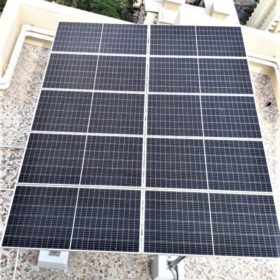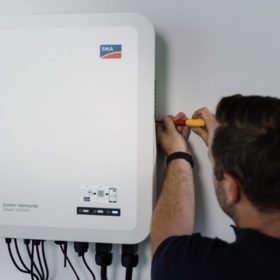Work begins on world’s largest PV system on a stadium roof
The stadium of German football club SC Freiburg will host a 2.4MW rooftop solar array that will be built with heterojunction modules provided by Swiss manufacturer Meyer Burger.
Rooftop solar price to keep rising this year
British analyst GlobalData has predicted residential and commercial rooftop panels will not return to a declining price trend until next year, with post-Covid logistics headaches the cause, rather than a polysilicon shortage.
Gujarat tenders 300 MW of ‘capex mode’ residential rooftop solar
March 7 is the last date to submit bids for the installation and commissioning of grid-connected rooftop solar plants in various sizes for rural residential consumers in the State.
New renewable energy capacity addition grew 73% year-on-year in the third quarter this fiscal
India installed 3,316 MW of non-hydro renewable energy capacity in the third quarter of FY2021-22, compared to just 1,914 MW installed in the same period last year. Out of this, 93% (3,072 MW) came from solar.
Vanadium redox flow battery to control extreme power ramps in rooftop PV
Researchers in Portugal have tested how vanadium redox flow batteries can be integrated with rooftop PV to balance the system load to ensure firm power output. They proposed a 5 kW/60 kWh battery configuration for a 6.7 kW building-integrated PV microgrid. According to their findings, the battery can be used in different energy management strategy scenarios to better complement solar photovoltaic generation.
ReNew Power sells rooftop solar portfolio to Fourth Partner
The NASDAQ-listed Indian renewable energy developer has sold off its 117 MW/138 MWp of distributed rooftop solar portfolio to Hyderabad-based Fourth Partner Energy for INR 6.72 billion (US$89.9 million), ensuring its increased focus on higher-return, larger-scale projects.
India’s solar and wind sector could employ one million new workers by FY2029-30
India could employ one million new workers through the deployment of 339 GW of wind and grid-connected solar systems (utility-scale solar and rooftop solar) between FY2021-22 and FY2029-30 if the nation were to meet its 500 GW non-fossil capacity target. The bulk of the new jobs would be created by small projects like roof-top solar and mini and microgrids.
New hybrid inverter for rooftop PV arrays from SMA
SMA’s new hybrid inverter reaches a maximum efficiency of 98.2% and a maximum European efficiency of 97.5%. It is compatible with DC-coupled high-voltage lithium-ion batteries from leading suppliers, according to the manufacturer.
The long read: Slow progress toward a big rooftop PV goal
A vibrant industry across the Middle East – including manufacturers, wholesalers, and a large number of EPCs and installers – supplies decarbonized electricity to meet growing air-conditioning demand, tapping the region’s abundant sunshine. However, progress toward this vision of a distributed-generation solar market segment and industry in the Gulf region has been slow, according to the president of the Middle East Solar Industry Association (MESIA), Ahmed Nada.
India may add 12.5GW of solar in 2022-23
Ratings agency ICRA expects the solar boost based on the backlog of PV projects awarded by central and state electric utilities.














